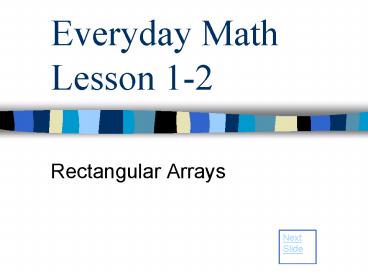Everyday Math Lesson 12 PowerPoint PPT Presentation
1 / 22
Title: Everyday Math Lesson 12
1
Everyday Math Lesson 1-2
- Rectangular Arrays
Next Slide
2
Key Concepts and Skills
- Find factors of a number
- Write number sentences for rectangular arrays
- Use the turn-around rule for multiplication
Next Slide
3
Vocabulary Words Which words would you like to
talk about?
- Array and rectangular array
- Multiplication
- Commutative Property of Multiplication
- Matrix
- Columns Rows
- Counting Numbers
- Product
- Factors and Factor Pairs
- Number Models of Multiplication
Next Slide
4
Mental Math Remember the Procedure?
- You need to write the numbers 1 through 8 on your
whiteboard. This is where you will write the
answers to the multiplication problems I read to
you. - During Mental Math, I will only read the problem
once. You need to quickly write down your answer
next to the problem number on your whiteboard.
Next Slide
5
Mental Math
- Did you notice the different symbols we can use
to show we are solving a multiplication problem? - You can use x or
- 3 x 5
- 3 9
- 7 x 6
- 7 x 7
- 4 9
- 8 x 7
- 8 x 4
- 9 x 7
- 15
- 27
- 42
- 49
- 36
- 56
- 32
- 63
Next Slide
6
Math Message
- Arrange the 12 counters you were given into as
many different rectangular arrays as you can.
Then choose and draw one of the arrays on your
white board. - Were going to share different arrays.
- How many ways can we come up with?
- 12 x 1 1 12 2 x 6 6 2, 3 by 4 4 3
Next Slide
7
Array Museum What could you say that is true
about each of these pictures?
Next Slide
8
Each array has these things in common
- Each row has the same number of objects
- Each column has the same number of objects
- Each array has a rectangular shape
- Lets look again and count the rows and columns
in my Array Museum
Go back to the Array Museum
9
Array and Rectangular Array
- An array is
- An arrangement of objects in a regular pattern,
usually in rows and columns. - A rectangular array means that the objects in the
array are lined up in rows and columns. - How many rows?
- 5
- How many columns?
- 7
Return to Vocabulary
10
A Rectangular Array has
The same number of items in each column
Columns 1 2
3 4
Row 1
- The same number of items in each row
Row 2
Return to Vocabulary
11
Multiplication
- Multiplication is repeated adding of the same
number. - Example
- 3 5 33333 15
- Another example
- 5 x 4 is just adding
- 5555 5 x 4 20
Return to Vocabulary
12
Commutative Property of Multiplication
- A rule that says changing the order of the
numbers in a multiplication problem wont change
the answer. - Also called the turn- around facts.
Return to Vocabulary
13
Matrix
- Matrix Method of doing multiplication problems
uses boxes to break apart the numbers being
multiplied.
Return to Vocabulary
14
Columns Rows
- Columns go up and down
- Rows go left and right
Return to Vocabulary
15
Counting Numbers
- It sounds so simple but counting numbers are just
the numbers we use to show our problems - 1, 2, 3, 4,5, 114, 230, 1,489 are all counting
numbers.
Return to Vocabulary
16
Factors and Factor Pairs
- Factors are one of two (or more) numbers that are
multiplied together to give a product. - For example
- 3 X 5 15
product
factors
Return to Vocabulary
17
Products
- The product is the result of answering a
multiplication problem. - For example, the product of 5 x 30 is 150.
PRODUCT
Return to Vocabulary
18
Number Models of Multiplication
- A number model of a multiplication problem is
taking the array we see in a picture and turning
it into numbers. - For example The array is showing 2 rows times 3
columns equals 6 pennies. - The number model is
- 2 x 3 6
2 x 3 6
Next Slide
19
Array Museum Count the Rows Columns
8 x 6 48
3 x 5 15
4 5 20
2 3 6
2 x 5 10
Next Slide
20
Practice What Youve Learned
- Find page 5 in your SMJ the floppy book.
- Working with a partner, each of you needs to
complete the questions on page 5 but you may work
together.
Next Slide
21
Addition and Subtraction Families
22
HOMEWORK Due tomorrow
- Complete Study Link 1-2, More Array Play.
- Notice that the top half of the page has you
drawing rectangular arrays and putting the number
model underneath. - The bottom part of the paper ask you to solve the
problems WITHOUT using a calculator.

